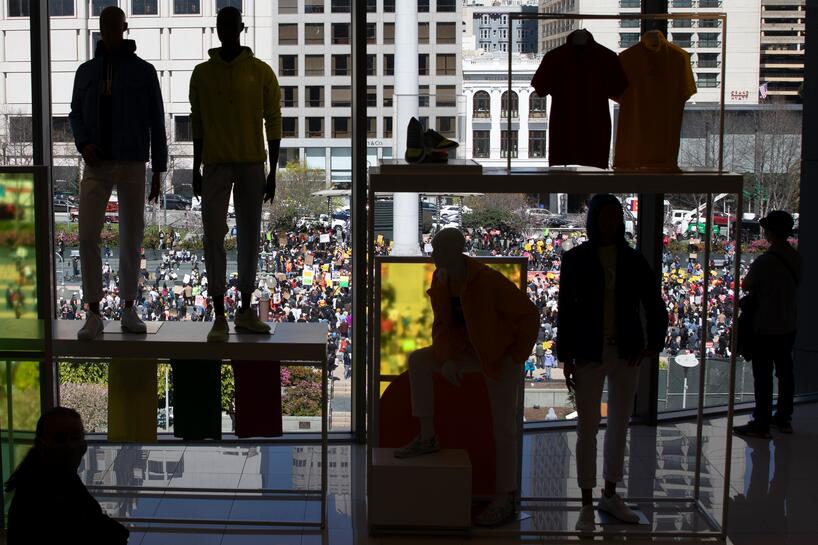亚裔只能做中层?偏见歧视成为亚裔职场“天花板”
来源:中国新闻网
9/15/2021

美国亚裔投资管理者协会(Association of Asian American Investment Managers)最新发布的一份报告显示,许多亚太裔员工正在经历过度的偏见和歧视。
综合福布斯新闻、CNBC9月14日报道,报告指出,对许多美国亚太裔而言,他们面临的障碍往往来自于日常职场生活,且常常体现在细枝末节上——如同事总是把亚裔员工的长相混淆,或者管理层对亚裔职员有着先入为主的设想,认为他们是“模范少数族裔”,通常比较胆怯或矜持。这种现象可能会阻碍亚太裔职工的事业发展,令他们被踢出项目团队,无法获得晋升机会。
这一现象具体体现在,各个行业里,亚太裔职工在企业中层管理职位中占比较大,但在高级管理和最高管理层中的比例却急转直下。
美国亚裔投资管理者协会的研究显示,65%的亚太裔管理者将“竹子天花板”(Bamboo Ceiling,特指职场中针对亚太裔的歧视和设限)视为对其职业生涯产生中度甚至重度的问题。且几乎所有受访者(90%)都认为,“竹子天花板”对其产生影响。这篇题为《亚裔是好员工而非领导者》(Good Workers-Not Leaders)的报告就通过以下几组统计数据阐述了职场中存在的结构性种族主义。
亚裔权益团体阿森德基金会(Ascend Foundation)的数据显示,在硅谷,每285名亚裔女性和每201名亚裔男性中仅有1人是企业高管。
另据联邦人事管理办公室(OfficeofPersonnelManagement,简称OPM)的数据,在联邦政府体系内,亚裔占员工总数的5.8%,占高管人数的3.5%。

Tel: 551-580-4856 | Email: F.WINNIE.S@GMAIL.COM
若以行业划分,在法律领域,亚裔占全美律师总数的5%,而其中的合伙人与助理律师的占比最低。在联邦法官中,亚裔法官占3%;州法官中,亚裔占2%。
在银行业,美国六大银行的最高层或高级管理人员中,亚裔占7%至19%,在中层管理人员和普通职员中,亚裔占23%。
值得注意的是,在最高管理层的人事变动中,亚裔更倾向于在企业衰落期间获得提拔,成为首席执行官,因为评估人员认为,亚裔领导人具有“自我牺牲精神”。然而,根据美国心理学会(American Psychological Association)进行的研究,企业经历的衰退期仅占其整体经营过程的12%,这表明,招聘人员可能只在有限的时段才会考虑亚裔担任领导职位。
在资产管理方面,尽管亚太裔职员的整体业绩达到或超过行业基准,但他们管理的资产只占整个行业的0.7%。
实际上,亚裔“难当大任”的陈旧观念来源于美国历史上存在已有的“模范少数族裔”观念。这一概念最早出现于1960年代,用于形容被人们视作“优越”的美国少数族裔群体。对于“优越”的含义,阿森德基金会高管丹尼斯·派克(Denise Peck)解释称:“在他人看来,我们个性顺从,成功地融入了美国文化。”
而在职场上,“一般来说,亚裔职员被认为是聪明、勤奋、易于管理的员工。”思科(Cisco)公司前副总裁巴克·吉(Buck Gee)表示,“这种思维方式的问题在于,我们被视为好员工,而无法成为好的领导者。”
巴克·吉补充说:“在美国,人们希望领导者具有敢于冒险的精神。然而,这些(理念)与中国和日本的文化并不相合。因此,在亚洲文化环境中长大的人们会在美国被视为不具备领导才能。”
Renegade Media执行主编安妮·金(Annie Kim)总结道:“我觉得,针对亚太裔的歧视给我们是谁、我们能成为什么样的人设置了一个隐形的屏障。”
美国中产阶级已经被掏空了
美联储为避免灾难而采取的干预措施,使得美国更容易遭受像2008年和2020年那样的金融危机。
文|迈特・彼得森(Matt Peterson)
3/14/2021
几十年来,凯伦・佩卓(Karen Petrou)一直扮演着银行、中央银行与大型投资者的顾问和导师的角色,帮助它们克服不断演变的货币和监管政策所带来的困惑。这是一项将冷静的分析置于主张之上的工作。
今天,随着她的新书《不平等的引擎: 美联储和美国财富的未来》的出版,情况发生了变化。佩卓告诉我: “这本书想做的事情是铸剑为犁”,本书是佩卓的第一本书,书中指控美联储处于一场不平等危机的中心,正是这场危机掏空了中产阶级。她认为美联储误解并误诊了美国的经济问题。
具有讽刺意味的是,美联储为避免灾难而采取的干预措施,使得美国更容易遭受像2008年和2020年那样的金融危机。低利率和其他美联储的非常规货币政策都未能推动中产阶级的财富增长,即便股市已经大幅上涨,但它让美国比以往任何时候都更加不平等。
佩卓认为,问题始于分析错误。她表示: “谈论统计错误可能看起来有点古怪,但糟糕的数据会导致糟糕的政策”。美联储本身似乎有时也同意这一观点。上周,美联储理事莱尔 ・ 布雷纳德(Lael Brainard)在一次演讲中承认,美联储过于依赖单一的失业指标,掩盖了劳动力市场的主要问题。布雷纳德是拜登政府提名的财政部长候选人之一。这种坦诚正是佩卓所希望看到的,尽管她希望能早上十年。
上周,我打电话给佩卓,听她详细介绍了自己的观点,并联系美联储请其置评。一位女发言人指出,美联储主席杰伊 ・ 鲍威尔(Jay Powell)最近在新闻发布会上讨论了美联储在解决不平等问题上的作用,他说,“我们希望建立一个人人都能参与的经济”。
为了清晰起见,我和佩卓的谈话记录经过了缩减和编辑。
《巴伦周刊》:你写道,美联储的政策针对的是一个不复存在的中产阶级,因此政策是失败的。中产阶级发生了什么?
凯伦・佩卓:中产阶级被掏空了。身为中产就意味着经济宽松、家庭安全以及子女能过上更好生活的想法已经过时了。除了最上层的10% ,这个国家所有人的债务都超过了他们的资产。举个例子,2018年,当美联储认为经济处于“良好状态”时,四分之一的中产阶级放弃了他们负担不起的医疗,这可不是中产阶级该有的样子。
《巴伦周刊》:为什么这对货币政策很重要?
凯伦・佩卓:无论是传统的货币政策还是2008年后的非传统货币政策,其前提都是两件现在不再存在的条件: 第一,银行业作为货币通过私营部门流动唯一驱动力; 第二,当利率下降时,中产阶级愿意背负更多债务来购买汽车或房屋,从而刺激就业,促进经济增长。
相反,姑且不谈银行能做什么的问题,当中产阶级已经债台高筑,买不起新车,或者因为信用评分过低而没有资格申请抵押贷款再融资时,那些传统的中产阶级理论上存在强烈的“边际消费倾向”的信号已经不再起作用。
《巴伦周刊》:为什么美联储还没有认识到这一现实?
凯伦・佩卓:并不是说美联储想让美国变得不平等。它确实希望经济增长具有更多弹性和能够分享。但它没有,因为它所有的决策数据点都是基于平均值或者累计值。美联储通常所依据的衡量指标可能曾经能告诉我们,比如价格是否稳定,但现在这些指标不能反映大多数美国人所处的实体经济。
失业率就是一个很好的例子。杰伊 ・ 鲍威尔和现在的莱尔 ・ 布雷纳德已经发表演讲,说我们没有正确地衡量失业率――就那个让我们感觉良好的名义最低失业率?事实上,失业率比我们想象中要高。
因此,当他们谈到2010年之后的最高就业率时,他们看到的是一个非常具有误导性的就业衡量标准。债务也是如此。从平均水平来看,债务水平是可负担和可持续的。但是当你细分一下,看看大多数美国家庭,你会发现我们的生活只能勉强糊口。
最有说服力的证据是,2018年――也是在“好时候”――当联邦政府短暂关闭时,平均年收入8.5万美元以上的联邦雇员中,近三分之二的人在失去工资后就无法支付房租或抵押贷款。人们一直生活在边缘,而美联储的数据并没有反映出这一点。
《巴伦周刊》:你提到了莱尔 ・ 布雷纳德关于失业的演讲。她说,新闻标题中的失业数字或多或少忽略了许多痛苦。你是否同意她解决这个问题的方法,即长期保持宽松的货币政策?
凯伦・佩卓:如果这种做法有用的话,我会同意。但如果你仔细看看美联储的超级宽松政策,当金融危机最严重的时候慢慢过去,从2010年开始,到2020年3月,我们的经济复苏是自二战以来最弱的。
我们的就业状况正是她所指出的那种比例失衡,大多数美国人的债务还在上升。金融市场迅猛发展,但所有这些都没有转化为资本投资或增长。即使是在前所未有的宽松政策之下,经济不平等也阻碍了美联储的政策效力。更多的宽松将让不平等更加严重。
《巴伦周刊》:为什么低利率不能刺激中产阶级的增长?
凯伦・佩卓:在过去十年的大部分时间里,实际利率基本上一直低于零。人们无法储蓄。公司将承担巨额的债务,因为它很便宜。但是,由于经济如此疲软,它们并没有将债务中的资金转化为工厂和设备,而是将其转化为资本分配、分红和股票回购。美联储庞大的投资组合已经把市场推向了非常高的水平,因为它把安全资产从系统中剔除了。它还为市场提供了一张安全网。
这种“缩减恐慌”(taper tantrum)其实并不常见,但它一旦发生就会吓坏美联储。2018年,美联储只是稍微修调整了一下利率,市场就说,“嘿,你把潘趣酒碗拿走了。”美联储接着就说,“哦,没关系,这里还有。”
看看2020年3月的金融体系是多么脆弱。当然,美联储不可能预见到一场大规模的传染疫情,但银行体系具有弹性。剩下的部分难以置信的不稳定。
《巴伦周刊》:也就是说,你把这种不稳定性归咎于美联储近10年的政策?
凯伦・佩卓:这是货币政策加上监管政策导致的结果。我并不呼吁放松管制,相反我认为,银行业强烈抱怨的高资本金规定造就了银行体系的稳定,使得银行成为了金融体系的支柱。但是银行并没有向家庭或者小企业提供大量贷款,而小企业才是经济增长的真正引擎。它们对信贷非常饥渴,因为把资本成本计算在内时,银行没法靠超低利率赚钱,即使他们不需要付任何钱给储户。
我们有越来越多的银行沙漠,因为银行系统正在转变成基本上只专注于交易和财富管理业务,因为这是有利可图的。这样一来,数万亿美元的超额准备金又回到了美联储。
《巴伦周刊》:你并不认为美联储应该什么都不做,尤其是在2008年,对吗?
凯伦・佩卓:不。你必须区分危机干预和之后的12年多的时间。如果经济处于如此良好的状态,为什么我们需要如此不可思议的宽松政策?这就是美联储在2010年至2020年间所说与所做之间矛盾的核心。
《巴伦周刊》:你希望看到什么样的政策变化?
凯伦・佩卓:美联储所犯的一个主要错误是将监管和货币政策视为“筒仓”(silos)。在美联储,它们是建筑的不同部分。他们是不同的人,双方几乎没有交谈,委员会对它们的看法也非常不同,但它们实际上是相互交织在一起的,例如,当你规定在超低利率的基础上提高银行贷款成本时,银行就不会放贷,非银行机构就会介入。这改变了金融体系,然后又改变了它的风险。
货币政策修正首先需要包括更好的数据,以了解美国的现状,而不是仍然使用像我和美联储的许多人在上研究生院时那样的数据。我认为,美联储必须理解金融体系的运作机制――边际消费倾向、借贷成本,以及这些因素会如何影响购买力,如何造成差异。
美联储正开始这么做,但它还有很长的路要走,因为下一步要做的事情是制定政策,着眼于分配的现实,而不仅仅是写很多关于它的论文。美联储必须认识到货币政策对平等有影响。仅仅只是大叫,然后转向财政政策是不够的,人们储蓄了多少,公司投资了多少“经济不平等与钱息息相关,没有什么比美联储制定的政策更能够直接推动金钱的增长了。

How the Fed Found Itself at the Heart of America’s Inequality Crisis
By Matt Peterson
3/03/2021
Karen Petrou has for decades played the quiet role of consultant and adviser to banks, central banks, and large investors, helping them slash through the confusion of constantly evolving monetary and regulatory policy. It’s a job that prioritizes dispassionate analysis over advocacy.
Today, that changes, with the publication of her new book, Engine of Inequality: The Fed and the Future of Wealth in America.
“This book is taking that sword and beating it into a plowshare,” Petrou told me. The book, Petrou’s first, charges that the Federal Reserve is at the heart of an inequality crisis that has hollowed out the middle class. She believes the Fed has misunderstood and misdiagnosed the country’s economic malaise. Its interventions to stave off calamity have, ironically, made America more prone to financial crises like 2008 and the one that was narrowly averted in 2020. Low interest rates and other elements of the Fed’s unconventional monetary policy have failed to spur middle-class growth, even as markets roared, leaving the country more unequal than ever.
Petrou believes the problems start with analytical errors. “It may seem geeky to talk about statistical mistakes, but bad data make bad policy,” she says. The Fed itself seems to agree at times. Last week, Lael Brainard, a Fed governor who was on the Biden administration’s shortlist for Treasury secretary, gave a speech in which she acknowledged that the Fed had relied too much on a single measure of unemployment that masked major problems in the labor market. That kind of admission is exactly what Petrou wants to see, though she’d rather it came a decade earlier.
I called Petrou last week to walk through her arguments, and reached out to the Fed for comment. A spokeswoman pointed to a recent press conference by Fed Chair Jay Powell at which he discussed the Fed’s role in addressing inequality. “We want an economy where everybody can take part,” he said.
This transcript of my conversation with Petrou has been condensed and edited for clarity.

Barron’s: You write that the Federal Reserve is aiming policy at a middle class that no longer exists and that therefore policy is fizzling. What has happened to the middle class?
Karen Petrou: The middle class is hollowed out. The idea of what being in that middle means—which is financial comfort, family security, and a better life for one’s children—that’s gone. All but the top 10% in this country have more debt than they have assets. We have a scenario in this country, where, for example, in 2018, when the Fed thought the economy was in a “good place,” a quarter of people in the middle class skipped medical treatments they couldn’t afford. That’s just not what middle class was supposed to mean.
Why does that matter for monetary policy?
Monetary policy, both conventional and the post-2008 unconventional policy, is premised on two things that don’t exist anymore: one, banks as the sole driver of how money moves through the private sector and, two, a middle class that when interest rates drop takes out more debt to buy something like a car or a house that then fuels employment and promotes economic growth. Instead, leaving the question of what the banks do aside for the moment, when the middle class is already way over its head in debt, and can’t afford a new car or is not eligible for mortgage refinancing because their credit scores are too low, those traditional signals of that theoretically resilient middle where there’s a strong “marginal propensity to consume” don’t work.
Why hasn’t the Fed come to grips with this reality?
It’s not that the Fed wants to make America less equal. It does genuinely want to make economic growth resilient and shared. But it hasn’t because all of its decision data points are averages or aggregates. Often they’re based on measures that once might have told us, for example, about price stability, but now don’t reflect the real economy for the majority of Americans. A good example is unemployment. Jay Powell and now Lael Brainard have made speeches saying we didn’t measure unemployment right. That nominal record-low unemployment that made us feel so good? Actually unemployment was higher than we thought.
So when they talked about maximum employment after 2010, all through that “good place” up until the pandemic hit, they were looking at a very misleading measurement of employment. The same thing is true for debt. Debt levels are affordable and sustainable when you look at it on an average. When you break it down and you look at most American households, you realize that we’re living hand to mouth.
The most compelling proof of that is the fact that in 2018—again, in the “good place”—when the federal government briefly shut down, federal employees who on average make $85,000-plus a year, almost two-thirds of them couldn’t pay their rent or the mortgage after missing a paycheck. People live on the edge. And the Fed’s data do not reflect that.
You mentioned Lael Brainard’s speech about unemployment. She said more or less that the headline unemployment figure misses a lot of misery. Do you agree with her prescription for the problem, which is to leave accommodative monetary policy in place for a long time?
I would agree with that, if it had worked. If you look at the Fed’s ultra-accommodative policy, starting from 2010, when the worst of the great financial crisis wore off, to March of 2020, we had the weakest economic recovery since the Second World War. We had exactly the disproportionate employment she points to. The amount of debt most Americans took out rose still higher. Financial markets zoomed. But none of that turned into capital investment or growth. Economic inequality, even with unprecedented amounts of accommodative policy, stymied the Fed. More of it is going to make inequality still worse.
Why are low interest rates not stimulating growth for the middle class?
Rates have been essentially below zero in real terms for most of the last decade. People can’t save. Companies will take on tremendous amounts of debt, because it’s cheap. But because the economy is so weak, they don’t turn the money in that debt into plants and equipment. They’ve turned it instead into capital distributions, dividends, and share buybacks. The Fed’s huge portfolio has driven markets up to very high levels because it’s taken the safe assets out of the system. And it’s also put a safety net under the markets.
The taper tantrum really wasn’t much. But it spooked the Fed when they stepped in. In 2018, they tinkered with rates just a little bit. The market said, “Hey, you’re taking the punch bowl away.” And the Fed said, “Oh, never mind. Here’s some more.”
Look how fragile the financial system was in March of 2020. Of course, the Fed could not have foreseen a pandemic, but the banking system was resilient. The rest of it was incredibly precarious.
And to be clear, you blame 10 years of Fed policy for some of that precarity?
It’s a combination of monetary and regulatory policy. I do not call for deregulation. I think the stability of the banking system wrought by high-capital rules that banks complained bitterly about made banks the bulwark of the financial system. But they aren’t lending a lot to households or startup small businesses, the real engines of growth. They’re starved for credit because banks cannot make money at ultra-low rates when you take their cost of capital into account, even when they’re not paying depositors for anything. We have increasing numbers of banking deserts because the banking system is turning into a business basically focused on trading and wealth management because that’s profitable. That and putting trillions of excess reserves right back at the Fed.
You don’t believe the Fed should simply have done nothing, particularly in 2008, right?
No. You have to differentiate between crisis intervention and then 12 more years. If the economy was in such a good place, why did we need such incredible accommodative policy? That’s the heart of the contradiction of what the Fed said versus what it did from 2010 to 2020.
What kind of policies would you like to see change?
One of the major mistakes the Fed made was viewing regulatory and monetary policy as silos. In the Federal Reserve, they are different parts of the building. They are different people. The two sides barely talk, and the board thinks about them very differently, but they’re actually tremendously intertwined because, for example, when you have rules that raise the cost of bank lending at ultra-low interest rates, then banks will not lend and non-banks will step in. That changes the financial system, which then changes its risks.
Monetary policy fixes need to first include better data to understand America as it is, not the way it was when a lot of the folks at the Fed and I went to graduate school. I think the Fed has to understand how the mechanics of the financial system—marginal propensity to consume, borrowing costs, and how that feeds into purchasing power—have all become really different.
The Fed is beginning to do that. But it’s got a long way to go because the next thing it has to do is to set policy with an eye toward that distributional reality, not just write a lot of papers about it. The Fed has to recognize that monetary policy has an impact on equality. It’s not good enough to just say, whoops, over to fiscal policy. How much people save, how much companies invest—economic inequality is about money, and nothing drives money more directly than the policy set by the Federal Reserve.










